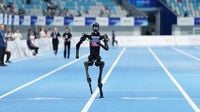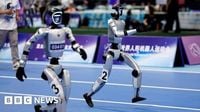The world of robotics has reached a new milestone this week as Beijing hosts the inaugural World Humanoid Robot Games, a first-of-its-kind event drawing more than 500 androids from 16 countries to compete in sports and practical challenges. The competition, which began on Friday, August 15, 2025, is taking place at the National Speed Skating Oval—the same venue that dazzled the world during the 2022 Winter Olympics. Now, instead of human athletes, the arena is filled with the whirring motors and blinking lights of humanoid robots, each vying for gold in events ranging from the 100-metre hurdles to kung fu, soccer, and even medicine categorization.
As reported by AFP and Reuters, the games kicked off with an opening ceremony on Thursday, August 14, featuring robots dancing and playing musical instruments alongside their human operators—a fitting start for an event that blurs the line between machine and man. The competition runs through Sunday, August 17, and is as much a showcase of technological prowess as it is a sporting spectacle.
For spectators like 18-year-old Chen Ruiyuan, the event is nothing short of inspiring. "I believe in the next 10 years or so, robots will be basically at the same level as humans," Chen told AFP. He is about to begin studying automation at university and sees the games as a catalyst for his own ambitions. "Coming here can cultivate my passion for this field. My favorite is the boxing, because... it requires a lot of agility and I can really see how the robots have improved from before."
Despite the optimism, human athletes need not worry about being outpaced just yet. At the five-a-side football match on Friday morning, ten robots—each about the size of a seven-year-old child—shuffled around the pitch, often getting stuck in a scrum or collapsing in a heap. In robot soccer, the level of play was a far cry from the likes of Messi, with robots clumsily knocking the ball forward and occasionally tumbling over each other, sometimes needing to be dragged off the field for a reboot. According to Reuters, the spectacle was as much about comic relief as it was about competition.
Still, there were moments that hinted at the robots' growing capabilities. In the 1500-metre race, Unitree's domestically produced humanoids stomped along the track at a pace that easily outstripped their rivals. The fastest robot finished the course in 6 minutes and 29.37 seconds—impressive for a machine, though still well behind the human men's world record of 3 minutes and 26 seconds. France 24 noted that another robot completed the race in 6 minutes and 34 seconds, nearly twice as long as the human benchmark. One mechanical racer even barreled straight into a human operator during the event. The robot remained standing, while the human was knocked flat—thankfully, no injuries were reported.
The games are not limited to traditional athletics. Robots are also competing in basketball, kickboxing, and more practical tasks such as medicine sorting and cleaning services. The variety of events provides engineers with a unique opportunity to test their latest technologies in a high-stakes, real-world environment. Max Polter, a member of Germany's HTWK Robots football team, told Reuters, "You can test a lot of interesting new and exciting approaches in this contest. If we try something and it doesn't work, we lose the game. That's sad but it is better than investing a lot of money into a product which failed."
For China, the games are more than just a technological showcase—they are a statement of intent. The Chinese government has placed humanoid robotics at the center of its national strategy, investing billions of dollars to position the country as a global leader in the field. In March 2025, Beijing announced a massive one-trillion-yuan (about $139 billion) fund to support technology startups, including those focused on robotics and artificial intelligence. The International Federation of Robotics wrote on Thursday, "The government wants to showcase its competence and global competitiveness in this field of technology." Official statistics show that China is already the world's largest market for industrial robots, and the country is determined to extend its dominance to the arena of humanoid machines.
This push is not just about prestige. Faced with an aging population and fierce competition from the United States and other tech powerhouses, China sees robotics as a critical component of its economic future. By fostering innovation and raising public awareness, the government hopes to inspire the next generation of engineers and scientists. Cui Han, who accompanied her 10-year-old son to the games, explained to AFP that his school had organized—and paid for—the trip. "I hope it will encourage him to learn more about these new technologies," she said, echoing the broader educational mission behind the event.
Robot competitions themselves are not new. Previous years have seen robots compete in soccer matches, run half-marathons, and even engage in kickboxing bouts. In April 2025, Beijing hosted what organizers called the world's first humanoid robot half-marathon, and in June, the city saw its first robot kickboxing contest. But this week’s event is the first to bring together so many humanoid robots from around the world to compete head-to-head in a full spectrum of Olympic-style sports and practical challenges.
Of course, the robots’ performances are a reminder of just how complex the human body is—and how far engineers still have to go. Building machines that can walk, run, and play sports like humans is no small feat. At the kung fu competition, one pint-sized robot resembling a character from the Transformers series attempted a dramatic move, only to fall flat on its face. It spun around helplessly on the floor as the crowd cheered it on, a scene that captured both the humor and the heart of the competition.
International teams have taken note of China's rapid progress. Joost Weerheim, an operator with a Dutch five-a-side robot football team, told AFP, "I think right now if they are not already the world leader, they are very, very quickly becoming it." The sentiment is shared by many in the robotics community, who see the games as a proving ground for new ideas and a glimpse into a future where robots and humans might one day share the playing field as equals.
As the games continue through the weekend, the world watches with a mix of amusement and awe. Whether it’s a robot tumbling over a hurdle or a child marveling at the possibilities of tomorrow, the World Humanoid Robot Games mark a turning point—not just for robotics, but for the way society imagines its relationship with technology. The crowd’s applause, the engineers’ pride, and the robots’ tentative steps all point to a future where the line between human and machine is ever more blurred—and the race is only just beginning.







